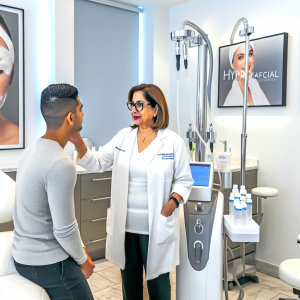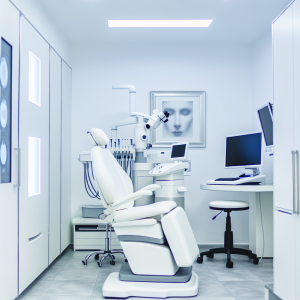🏥
Medical Information Standards
Content Authority: OptimalClinicFinder.com is a comprehensive medical directory platform connecting patients with qualified Pdo Thread Lift providers. Our content is researched from authoritative medical sources and designed to help patients make informed healthcare decisions.
How PDO Thread Lifts Work: Clinical Mechanism and Applications
PDO (polydioxanone) thread lifts work through a dual mechanism that provides both immediate and long-term aesthetic benefits. The immediate effect comes from mechanical lifting as threads are strategically placed under the skin to physically reposition sagging tissues and create enhanced facial contours. The threads act as a supportive scaffold, lifting drooping skin and redistributing facial volume to restore youthful proportions.
The long-term benefits develop through biostimulation, as PDO threads trigger the body’s natural healing response and stimulate fibroblast activity. This process increases collagen and elastin production around the thread placement sites, creating natural tissue strengthening and skin tightening that continues to improve for 3-6 months after treatment. The threads themselves are fully biodegradable, dissolving completely within 6-8 months while leaving behind the newly formed collagen matrix for sustained results.
💡
Did You Know?
Clinical studies show that Pdo Thread Lift patients achieve excellent results when combined with professional-grade aftercare products.
Types of Threads and Clinical Applications
Modern thread lift procedures utilize several types of PDO threads, each designed for specific applications and treatment areas. Smooth threads are primarily used for skin tightening and collagen stimulation, particularly effective for fine lines, skin texture improvement, and mild laxity. These threads create a mesh-like support structure under the skin without providing significant mechanical lifting.
Barbed or cog threads feature directional barbs that anchor into tissue, providing substantial lifting power for moderate to severe skin laxity. These threads are ideal for jawline definition, cheek lifting, brow elevation, and neck tightening. Tornado or screw threads combine lifting capability with enhanced biostimulation, making them versatile for both lifting and volumizing applications. The selection of thread type depends on patient anatomy, desired outcomes, and the treating physician’s assessment of optimal treatment approach.
Treatment Protocols and Clinical Management
Successful thread lift treatment begins with comprehensive patient consultation and treatment planning. The initial evaluation includes facial analysis, skin quality assessment, degree of laxity measurement, and realistic outcome discussion. Patients must understand that thread lifts provide subtle to moderate improvement compared to surgical facelifts, making appropriate candidate selection crucial for satisfaction.
The treatment protocol involves precise thread placement using specialized cannulas or needles under topical or local anesthesia. Most procedures require 30-60 minutes depending on treatment area and number of threads used. Post-treatment care includes specific positioning instructions, activity restrictions, and symptom monitoring. Patients typically experience mild swelling and bruising for 3-7 days, with full results visible after 2-4 weeks once initial swelling resolves and threads settle into optimal position.
💡
Quick Tip
Pdo Thread Lift works best when combined with healthy lifestyle choices for optimal results.
Safety Profile and Complication Management
PDO thread lifts have an excellent safety profile when performed by qualified practitioners using proper technique. The most common side effects include temporary swelling, bruising, tenderness, and mild asymmetry that typically resolves within 1-2 weeks. These effects are generally well-tolerated and managed with standard post-procedure care including cold therapy, gentle cleansing, and activity modification.
Serious complications are rare but can include thread migration, infection, nerve injury, or visible thread placement. Thread migration occurs in less than 2% of cases and may require thread removal or repositioning. Infection risk is minimized through sterile technique and appropriate post-care instructions. Nerve injury is extremely rare when treatments are performed by experienced practitioners with thorough anatomical knowledge. Patient education about warning signs and clear follow-up protocols ensure early detection and management of any complications.
Threads Plastic Surgery Cost Analysis and Financial Considerations
The cost of threads plastic surgery varies significantly based on multiple factors including geographic location, provider experience, facility type, thread quantity, and treatment complexity. National average costs range from $2,800-$3,500 for comprehensive facial thread lift procedures, with individual treatment areas typically costing $800-$1,500. Premium locations and highly experienced providers may charge 20-40% above average rates, reflecting expertise and enhanced service levels.
⚠️
Safety First
Always consult a qualified medical professional before starting Pdo Thread Lift. Results vary by individual.
Unlike traditional plastic surgery, thread lifts are generally not covered by insurance as they are considered elective cosmetic procedures. However, the significantly lower cost compared to surgical facelifts makes thread lifts accessible to more patients. Many providers offer financing options, package deals for multiple areas, or maintenance treatment discounts. When evaluating costs, patients should consider the provider’s qualifications, facility accreditation, thread quality, and comprehensive care rather than selecting based solely on price.
Provider Selection and Treatment Access
Choosing a qualified provider is the most critical factor in achieving safe, effective thread lift results. Patients should seek board-certified plastic surgeons, dermatologists, or other physicians with specialized training in thread lift techniques and facial anatomy. Provider qualifications should include formal thread lift certification, ongoing education, significant procedure volume, and documented outcomes with before/after photography.
✓
Why Choose Pdo Thread Lift?
●
Clinically proven
●
FDA approved
●
Minimal downtime
●
Long-lasting
The consultation process should include thorough facial analysis, realistic expectation setting, detailed procedure explanation, and comprehensive consent discussion. Qualified providers will discuss alternative treatments, combination approaches, and long-term maintenance strategies. Red flags include extremely low pricing, high-pressure sales tactics, unlicensed practitioners, or facilities lacking proper accreditation. Patients should feel comfortable asking about provider credentials, complication rates, and revision policies before proceeding with treatment.
Results Timeline and Maintenance Strategies
Thread lift results develop in phases, with immediate lifting visible after treatment, optimal results appearing at 4-6 weeks, and continued improvement for 3-6 months as collagen production increases. Initial swelling may mask some lifting effects, so patients should allow adequate time for final result assessment. Most patients achieve 60-80% of surgical facelift improvement with significantly less downtime and risk.
Results typically last 12-18 months, depending on individual factors including age, skin quality, lifestyle, and thread type used. Maintenance treatments can extend results, with many patients choosing touch-up procedures every 12-15 months. Combining thread lifts with complementary treatments like neurotoxins, dermal fillers, or energy-based devices can enhance and prolong results. A comprehensive anti-aging approach including professional skincare, sun protection, and healthy lifestyle habits optimizes long-term outcomes and extends time between treatments.
📚 Medical Authorities & Professional Standards
All Pdo Thread Lift procedures should be performed by licensed medical professionals following established clinical guidelines and safety protocols.
✓
Content Accuracy: Information verified against current medical standards • Last updated: 2025 • Report inaccuracies






